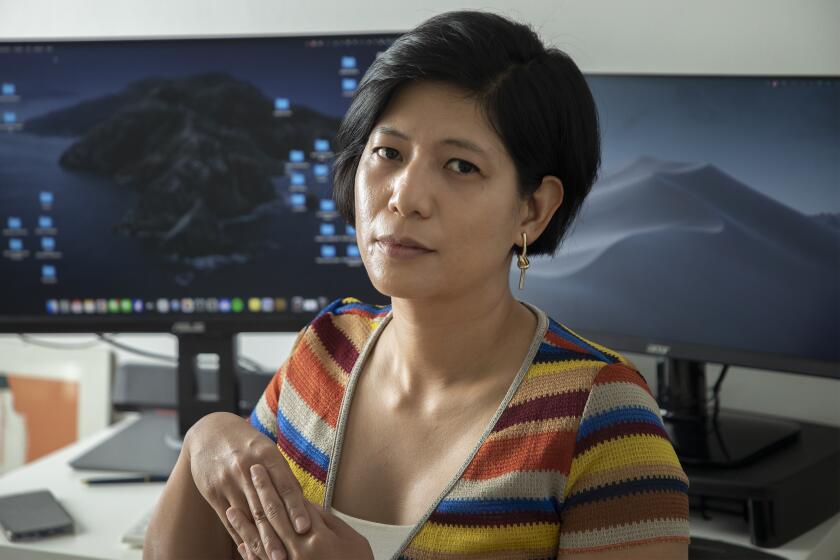
Production designer Dave Blass wrapped his last big project, filming the Paramount+ series “Star Trek: Picard” in L.A. in 2022 before the Writers Guild and SAG-AFTRA walkouts hit last year. Even now, almost a year after those strikes ended, the two-time Emmy nominee for “Justified” says Hollywood’s production designers, set decorators and their crews still have little work.
“I’m just trying to stay positive and get through this,” says Blass, 55, adding that others are far worse off. “Most people have been hanging on by their fingernails, and they’re running out of fingernails. I know Emmy Award winners who are driving around delivering auto parts.”
For the record:
10:29 a.m. Aug. 26, 2024An earlier version of this article misstated where “Star Trek: Picard” was filming. The location was Los Angeles, not Toronto.
To pay bills, Blass has taken short-term graphic design gigs and sold autographs at “Star Trek” conventions. He is taking lessons to become a FAA-licensed drone photographer for real estate listings. “It’s like you’re starting from scratch,” he says.
As a member of what is broadly known as the art department — production designers, set decorators, art directors, graphic artists, illustrators, model makers, scenic painters, construction crews and more — Blass belongs to the vast pool of below-the-line talent who do not earn profit participation or residuals. Nevertheless, during the 2023 strikes, these artisans picketed in solidarity with the writers and actors who continue to make money after the final frames are shot.
As reality TV takes a hit amid a slowdown in Hollywood production, crew members lament the loss of jobs to “runaway production,” cutbacks and consolidation.
The hourly workers (with rates that start around $40 an hour) and flat-fee weekly contract players of the art department are responsible for transforming the blank canvases of soundstages and back lots into the suburban cul-de-sacs and intergalactic space stations you see on-screen. Yet despite the recent ratification of their own union contracts, with a 7% pay bump in hourly rates for the first year, many art department workers are still looking at plummeting bank balances and blank work schedules as Hollywood’s TV and film businesses contract and the flight of production overseas contributes to a painful industry slowdown.
“It’s not easy for a production designer to pivot,” says Suzuki Ingerslev, a 30-year veteran of hit shows such as HBO’s “True Blood” and “Six Feet Under,” noting that carpenters can do home renovations, painters can paint houses and set decorators can shift their skills to interior design.
After 18 years, Jennifer Fulmer, a set decorator on four seasons of ABC’s “black-ish” spinoff “Grown-ish,” says the slowdown has made her feel like she’s stepped back in time to the early years of her career. She hasn’t worked since March, and her income has dropped by half.
“I know a lot of people who have moved. One set dresser I know is working as a lifeguard this summer,” she says. Fulmer earns money from an Airbnb in Big Bear that she owns and decorated, and she has been considering a side hustle helping people decorate their Airbnbs or doing event planning.

Cheryl Murphy, 54, joined IATSE Local 44 in 2000 as a buyer for set decorators and, 20 years later, became one herself. The pandemic, strikes and subsequent production pauses made finding jobs in her new union classification challenging.
“Becoming a set decorator was a whole new hustle,” she says. “I had to make a new set of connections.” She has been unemployed for more than a year and a half and finds it hard to respond when friends and neighbors have asked, “The strikes ended, so what do you mean you’re not working?”
“You’re in this frozen state because you don’t want to take another [side] gig that you’d have to quit immediately when a set decorating job comes along,” Murphy says. “It’s taxing financially and emotionally, weird, depressing, frustrating.” She’s taken up pet sitting and odd jobs like painting houses. “I’ve started to do personal organizing, which I like,” she adds, “it’s basically Marie Kondo-ing the s— out of people’s houses.”
For more than 40 years, property master Ellen Freund has provided “anything an actor touches and holds,” she says, in high-profile projects including 52 episodes of “Mad Men” and the Tom Ford-directed film “Nocturnal Animals.” Though based in Los Angeles, Freund largely works overseas, where she trains locals who often rise rapidly to more senior positions than L.A. counterparts because of the smaller talent pool.
Freund finished the second season of the AMC series “Interview With the Vampire” in Prague before last Christmas. “My phone has not been ringing since returning,” she says. “I know there is work on low-budget productions in Los Angeles right now, but it’s not what I would be called for.” In the meantime, she is freelancing as head of production for Poppy Bright Entertainment, representing Dunkin’ Donuts and Tona Beer for free product placement on camera. “It’s not full time,” Freund says, “but it’s making my mortgage.”
With Hollywood production activity and employment down while the cost of living rises, some film and TV workers are leaving Los Angeles — and California.
The crews and assistants who work for department heads are also feeling the pinch. Charles Serrano, a Local 44 set construction coordinator since 1985 on multicamera TV shows, might hire 25 laborers just to shoot a pilot. He estimates that he and his crews have lost at least 25% of their work since 2021.
“I can’t be out there swinging a hammer with guys in their 20s,” says Serrano, 63, who lives in Santa Clarita and has what’s often two hours of commuting to and from work, which, lately has included repair work on studio soundstages and short stints on pilots. “Without this last pilot, I was one month away from losing my medical benefits and having to take retirement.”
Younger newcomers to the industry have been particularly challenged by the current production vacuum, which recently caused the Art Directors Guild to pause its Production Design Initiative, a program designed to provide mentorship, supervision and on-the-job training that helps put candidates on a path to becoming assistant art directors.
Reality TV production levels are way down compared with last year. Workers and industry experts are weighing in on the decline.
Many art department creatives have also weathered personal crises: losing homes or the opportunity to buy them, relocating, breaking up and divorcing. In the current economy, even joyful life events can become stressful. Set decorator Ayse Arf, 41, worked for six weeks in 2023 and then had her first child last May. After qualifying for $450 a week in unemployment for 25 weeks, disability payments and California paid family leave, she has been living off her savings while adjusting to the demands of motherhood.
“I’ve been thinking, how am I going to survive? Do I need to change careers?” Arf says. “I asked a mentor how to level up in my career and he said go to a different market.”
Even in boom times, the Hollywood film industry’s long hours are “not kind to people with young families,” says scenic painter Miriam Hellmann, 37. As a 10-year member of Local 729 (IATSE set painters and sign writers), she began to pivot after the birth of her second child just before the pandemic when, she says, “streamers were throwing spaghetti against the wall, which had all the earmarks of a tech bubble that would burst.”
Now that the industry is contracting, she devotes more of her time to her business, Offwrld Murals. “When the strikes started, I got to employ scenic painters I have worked with who were out of work. We’ve done murals on new apartment buildings and restored a 1920s theater,” she says. “I’m not going to give up because people still value work that is handcrafted with care. To me, AI is wasteful. I would rather see something real than a computerized remix.”

Protections and regulations around artificial intelligence, a key issue in the writers’ and actors’ strikes, may be even more crucial for designers, says Brett Phillips, a model maker who creates 3-D architectural scale models of sets for the Marvel Cinematic Universe.
“Do I have a viable career for the next 10 years before I reach retirement age?” he asks. “AI is not going away, and I’m really concerned for people who are coming into model making now.”
Lissette Schettini, a member of IATSE Local 800 for 25 years, worked her way up from production assistant to production designer and worked as a graphic designer on “Abbott Elementary.” She is tackling the emerging technology head-on.
“In 2024, I’ve worked a total of two weeks,” she says, noting that she has not had a production design job since May 2023. Her rent rose to $2,500 in January, and the money Schettini had set aside for a down payment on a house is dwindling. “I had almost $90,000 set aside to buy a house and that is pretty much gone.” She has recently enrolled in a master’s program to learn digital art, 3-D design and animation. “We’re all scared of AI taking our jobs,” Schettini says, “so I figured I might as well learn it.”
As LACMA exhibits decades of ceramics, painting and drawing, the artist reflects on the devastating sacrifices she made along the way. “I paid my price, I can tell you.”
Most industry employees see the slow and painful restart of made-in-L.A. production as part of a broader business-model reset.
“I don’t see the old-school 22-episode orders anymore,” says assistant art director and set designer Gail Russell, who since 1996 has specialized in multicamera sitcoms like CBS’ “Bob Hearts Abishola.” “I’ve had six weeks of work since April of this year and feel like there’s going to be a lot of hopping around, shooting 10 episodes and then not doing the next 10 for five months. I’m in a $1,175-a-month apartment and they’re going to have to scrape me off the floor at some point. But I got to keep the good vibes pushing out, cause people can smell fear.”
In addition to technology that has the power to eliminate even more jobs, “the worst part is that no one can give us a clear outlook on where we are heading,” says Mara LePere-Schloop, a production designer with two decades of prestige TV series credits including Prime Video’s “Tom Clancy’s Jack Ryan,” Apple TV+’s “Pachinko” and “Interview With the Vampire.” “Other than, if you have a job offer, take it.”
Increasingly, that also means taking your show on the road, to places where productions have moved for tax credits and other incentives. “The dream of living and working in L.A. is becoming more difficult,” says Wes Hottman, an art director for film and television. “You have to be willing to go wherever and whenever the work is.” His colleague, assistant art director Megan Pulone, adds that for people in their early 30s, “the new normal is leaving California to get jobs in Georgia, Texas, Montana and even Hawaii.”
“California is the fifth largest economy in the world,” Blass states pointedly. “Why aren’t we blowing Georgia’s tax credits out of the water to keep Hollywood in Hollywood?”
“It’s a race to the bottom,” says Art Directors Guild National Executive Director Chuck Parker. “In almost all situations around the globe, you’re going to settle for a skill set that is much less than what we have available right here in Los Angeles.”
The cultural impact of the city’s entertainment properties is dependent on the vast resources and generations of expertise that can be found only in Los Angeles, according to Art Directors Guild President Dina Lipton. “How would ‘Star Trek’ be made without the Enterprise, or ‘Cheers’ without that bar?” she asks. “How could you go ‘Back to the Future’ without the art department?”
Michael Wylie, who will be returning to the set of “Avatar: The Last Airbender” after 18 months without work, remains committed to the power of visual storytelling.
“We just came out of this second golden age of television and now we’re in a desert wasteland. I have to believe this is a cycle that will end, everyone will stab the beast and get a big piece of steak and then we can go back to work and do cool stuff. I have 25 years of experience at a high level,” says the production designer, who recently turned 60. “Don’t throw me on the heap just yet.”
More to Read
Subscriber Exclusive Alert
If you're an L.A. Times subscriber, you can sign up to get alerts about early or entirely exclusive content.
You may occasionally receive promotional content from the Los Angeles Times.










